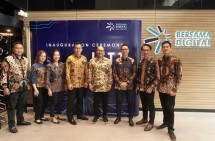Mercury-free UVC disinfection – Asahi Kasei demonstrates how Crystal IS UVC LED technology can be applied to achieve higher disinfection efficiency in water treat- ment than conventional mercury lamp
By : Nata Kesuma | Thursday, October 06 2022 - 21:26 IWST

Asahi Kasei Europe GmbH
INDUSTRY.co.id - New York, Tokyo, and Düsseldorf, 5 October 2022 – Asahi Kasei, a diversified Japanese multinational company, and subsidiary Crystal IS have concluded in a bacterial perfor- mance test, an experimental Klaran™ WR water treatment reactor demonstrated over 75% higher performance than a traditional low pressure mercury lamp system using an equiv- alent power consumption level.
Klaran™ WR experimental water treatment reactor demonstrated over 75% higher perfor- mance than a traditional mercury lamp system in a bacterial performance test.
The Klaran™ WR reactor provides a lighter weight, smaller size, longer lasting and safer alternative to mercury lamps.
Asahi Kasei and Crystal IS advancements in UVC LED technology contribute to sustainability in society and are an important step towards actualizing a mercury-free world.Klaran™ WR is an inline Point of Use (PoU) water treatment reactor (Fig. 1, left) which combines Crystal IS’ UVC LEDs based on aluminum nitride (AlN) substrates (Fig. 1, right), with Asahi Kasei’s R&D capability in the design and application of optics and fluid-dynamics.
While conventional UV water treatment systems have used mercury lamps as a light source, nations around the world adopted stricter regulations after the Minamata Convention on Mercury became effective in 2017, due to the hazards that mercury poses to health and the environment. UVC LEDs have been developed as a mercury-free light source featuring small size, light weight, and flexibility in design. A key milestone speeding the transition to this modern light source is demonstrating that the disinfection performance, power efficiency and value of the new LED technology can fully meet or exceed the incumbent mercury lamp.
While it is widely understood and accepted that UVC LED’s instant on-off capability offers a significant advantage and better alignment with actual consumer use than an “always on” mercury lamp system, a question remained whether an equivalent powered LED system could demonstrate equivalent disinfection performance as a low-pressure mercury lamp system. The experimental Klaran™ WR reactor was developed to demonstrate that UVC LEDs can achieve just this.
A standard Klaran™ WR was enhanced and modified to operate with the same power consumption level (6 W) as a comparable mercury lamp system (Fig. 2). Both systems were tested using water at a flow rate of 8 liters per minute (2.1 gallons per minute), with a UV transmittance of 97% at 265 nm and dosed with the addition of approximately 106 CFU/mL of E. coli, a common gram-negative, facultative anaerobic, rod-shaped bacterium, for testing.
As there is no established testing method for this type of comparison, Asahi Kasei devised the testing method and contracted an independent laboratory to perform the evaluation. Water quality samples recorded after 2 minutes steady operation with both systems were compared (Fig. 3), demonstrating how the Klaran™ WR had over 2 LRV(logarithmic reduction value) better performance than the mercury lamp system. Put another way, the Klaran™ WR system reduced E. Coli in the water to 1/100 of the level of the water disinfected by the mercury lamp system.
Read Also
Modena Officially Becomes a Member of the UN Global Compact
UAE's Technology Innovation Institute Launches Open-Source "Falcon…
Crystal IS and Asahi Kasei Announce New Record for Single-Chip Device…
Universal Robots reports record revenue despite global uncertainty
New Gigabit Ethernet Switches From Red Lion Simplify Configuration…
Today's Industry

Sabtu, 14 September 2024 - 16:56 WIB
Essential Tips for Choosing Personal Health Insurance in the US
Choosing the right health insurance plan in the United States can be a complex task, especially with the variety of options available and the ever-changing landscape of healthcare policy. Here…

Sabtu, 14 September 2024 - 16:53 WIB
The Top 10 Insurance Companies in the US for 2024
In the ever-evolving landscape of insurance, selecting the right company can significantly impact your financial security and peace of mind.

Jumat, 13 September 2024 - 15:37 WIB
Why Airbnb Become Popular in 2024?
Airbnb fosters a more interactive experience between hosts and guests. Through direct messaging, guests can inquire about specific details, negotiate pricing, or clarify expectations, which…

Kamis, 11 Juli 2024 - 22:08 WIB
Totolink Strengthens Commitment to Innovative and Reliable Network Solutions for Indonesia
Marking a strategic step, Totolink Indonesia proudly announces the enhancement of its head office in Jakarta, located at Harco Mangga Dua Blok E No.28, Sawah Besar, Central Jakarta.

Kamis, 11 Juli 2024 - 19:03 WIB
BDDC Inaugurates JST1 TIER IV Data Centre in Jakarta to Strengthen Digital Infrastructure
Bersama Digital Data Centres (BDDC), an in-town data centre provider with interconnectivity and integrated digital systems, inaugurated its 5 MW Tier IV data centre facility, JST1 (Jakarta Selatan…















News Comment